wheel Citroen JUMPY MULTISPACE 2011 2.G Owner's Manual
[x] Cancel search | Manufacturer: CITROEN, Model Year: 2011, Model line: JUMPY MULTISPACE, Model: Citroen JUMPY MULTISPACE 2011 2.GPages: 268, PDF Size: 10.1 MB
Page 3 of 268
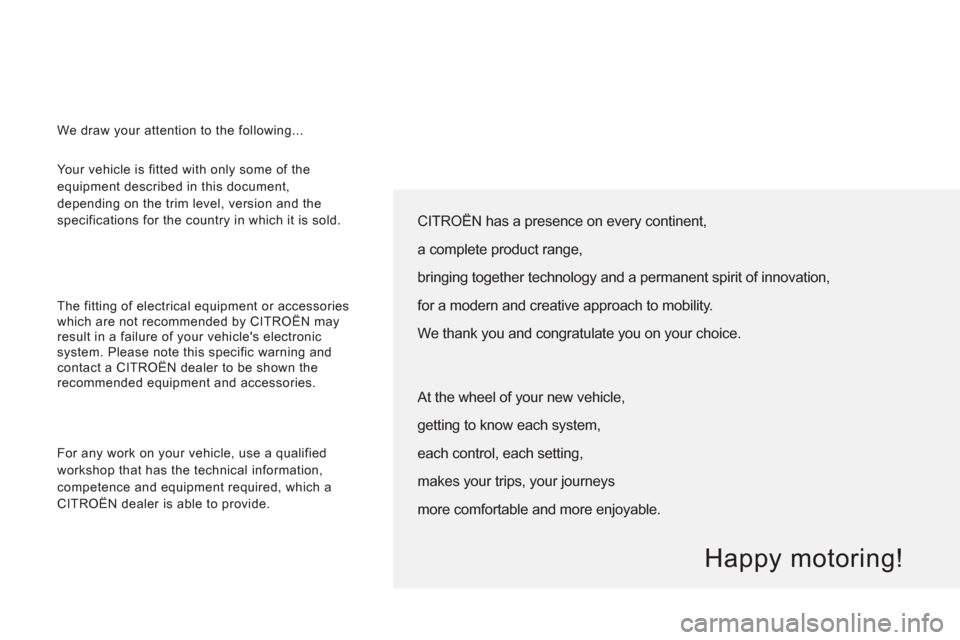
Your vehicle is fitted with only some of the
equipment described in this document,
depending on the trim level, version and the
specifications for the country in which it is sold.
The fitting of electrical equipment or accessories
which are not recommended by CITROËN may
result in a failure of your vehicle's electronic
system. Please note this specific warning and
contact a CITROËN dealer to be shown the
recommended equipment and accessories.
CITROËN has a presence on every continent,
a complete product range,
bringing together technology and a permanent spirit of innovation,
for a modern and creative approach to mobility.
We thank you and congratulate you on your choice.
Happy motoring!
We draw your attention to the following...
At the wheel of your new vehicle,
getting to know each system,
each control, each setting,
makes your trips, your journeys
more comfortable and more enjoyable.
For any work on your vehicle, use a qualified
workshop that has the technical information,
competence and equipment required, which a
CITROËN dealer is able to provide.
Page 4 of 268
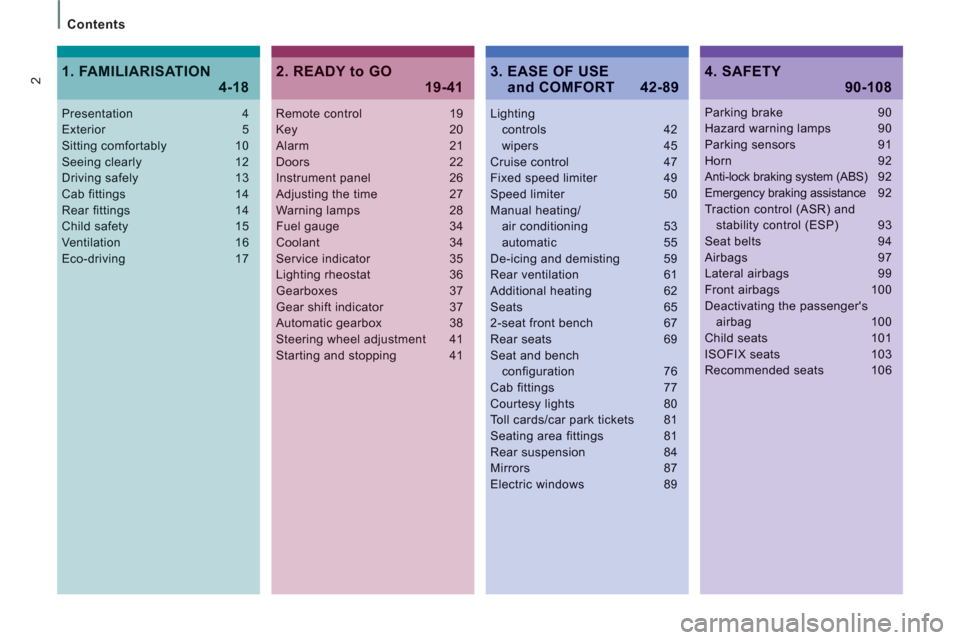
2
Contents
Remote control 19Key 20Alarm 21Doors 22Instrument panel 26Adjusting the time 27Warning lamps 28Fuel gauge 34Coolant 34Service indicator 35Lighting rheostat 36Gearboxes 37Gear shift indicator 37Automatic gearbox 38Steering wheel adjustment 41Starting and stopping 41
Lightingcontrols 42wipers 45Cruise control 47Fixed speed limiter 49Speed limiter 50Manual heating/air conditioning 53automatic 55De-icing and demisting 59Rear ventilation 61Additional heating 62Seats 652-seat front bench 67Rear seats 69Seat and benchconfiguration 76Cab fittings 77Courtesy lights 80Toll cards/car park tickets 81
Seating area fittings 81Rear suspension 84Mirrors 87Electric windows 89
Presentation 4Exterior 5Sitting comfortably 10Seeing clearly 12Driving safely 13Cab fittings 14Rear fittings 14Child safety 15Ventilation 16Eco-driving 17
Parking brake 90Hazard warning lamps 90Parking sensors 91Horn 92Anti-lock braking system (ABS) 92Emergency braking assistance 92Traction control (ASR) andstability control (ESP) 93Seat belts 94Airbags 97Lateral airbags 99Front airbags 100Deactivating the passenger'sairbag 100Child seats 101ISOFIX seats 103Recommended seats 106
2. READY to GO
19-41
4. SAFETY
90-108
1. FAMILIARISATION
4-183. EASE OF USE and COMFORT 42-89
Page 5 of 268
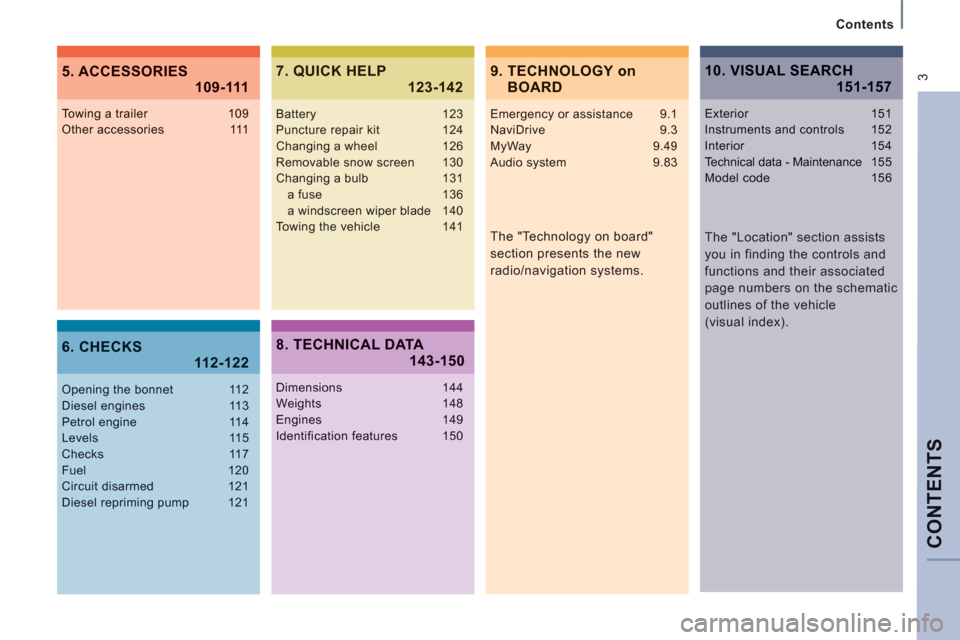
CONTENT
S
Contents
3
The "Technology on board"
section presents the new
radio/navigation systems.
Towing a trailer 109Other accessories 111
Opening the bonnet 112Diesel engines 113Petrol engine 114Levels 115Checks 117Fuel 120Circuit disarmed 121Diesel repriming pump 121
Battery 123Puncture repair kit 124Changing a wheel 126Removable snow screen 130Changing a bulb 131a fuse 136a windscreen wiper blade 140
Towing the vehicle 141
Dimensions 144Weights 148Engines 149Identification features 150
Exterior 151Instruments and controls 152Interior 154Technical data - Maintenance 155Model code 156
9. TECHNOLOGY onBOARD 5. ACCESSORIES
109-111
6. CHECKS11 2-122
7. QUICK HELP 123-142
8. TECHNICAL DATA143-150
10. VISUAL SEARCH151-157
The "Location" section assists
you in finding the controls and
functions and their associated
page numbers on the schematic
outlines of the vehicle
(visual index).
Emergency or assistance 9.1NaviDrive 9.3MyWay 9.49Audio system 9.83
Page 6 of 268
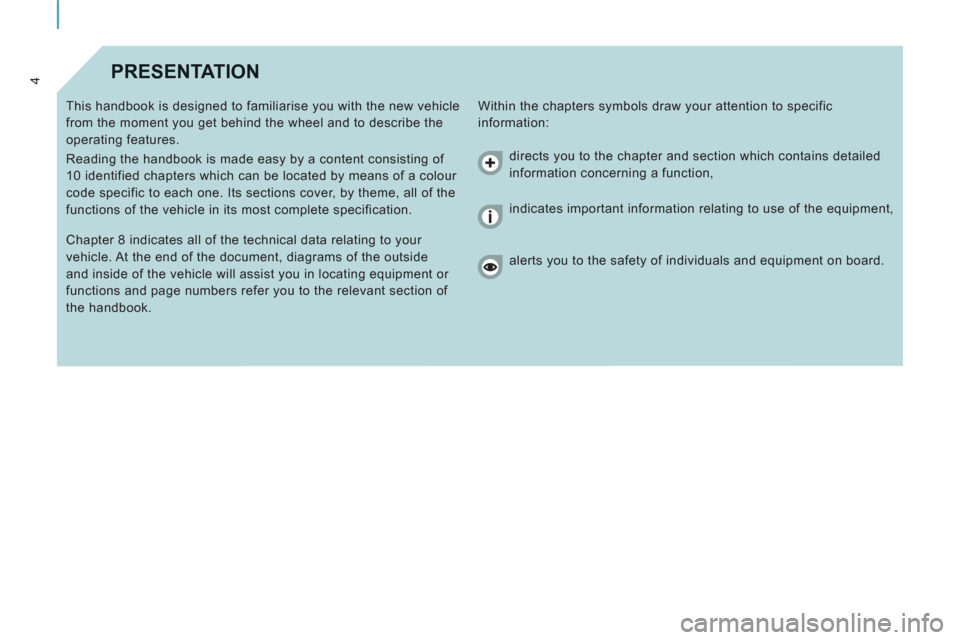
4PRESENTATION
Within the chapters symbols draw your attention to specific
information: This handbook is designed to familiarise you with the new vehicle
from the moment you get behind the wheel and to describe the
operating features.
Reading the handbook is made easy by a content consisting of
10 identified chapters which can be located by means of a colour
code specific to each one. Its sections cover, by theme, all of the
functions of the vehicle in its most complete specification.
Chapter 8 indicates all of the technical data relating to your
vehicle. At the end of the document, diagrams of the outside
and inside of the vehicle will assist you in locating equipment or
functions and page numbers refer you to the relevant section of
the handbook. directs you to the chapter and section which contains detailed
information concerning a function,
indicates important information relating to use of the equipment,
alerts you to the safety of individuals and equipment on board.
Page 8 of 268
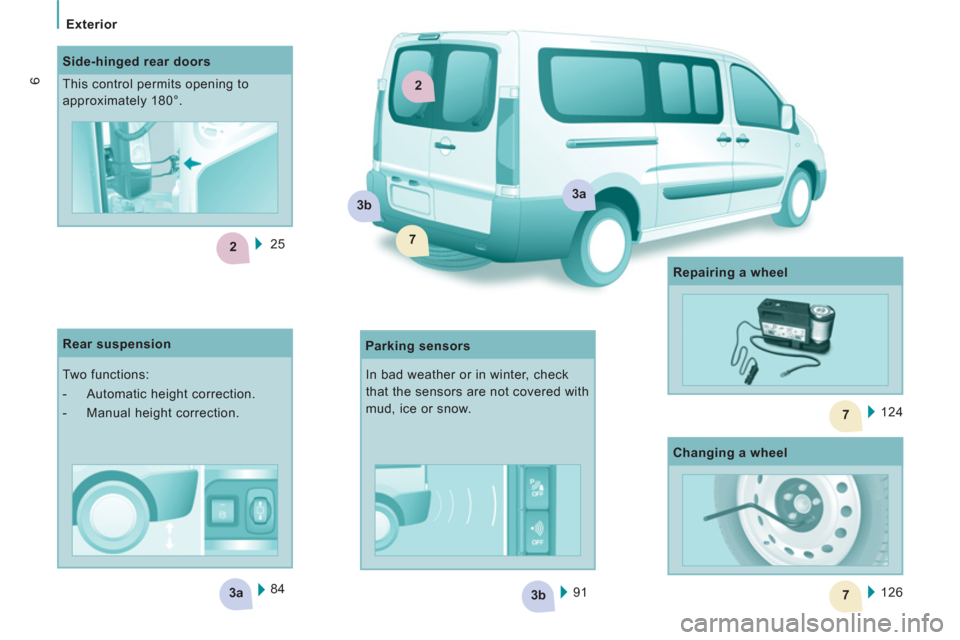
3b3a
2
7
7
2
3a3b
7
Exterior
6
91 84
Side-hinged rear doors
This control permits opening to
approximately 180°.
Parking sensors
Rear suspension
Two functions:
- Automatic height correction.
- Manual height correction. 124
Repairing a wheel
In bad weather or in winter, check
that the sensors are not covered with
mud, ice or snow.
126
Changing a wheel 25
Page 10 of 268
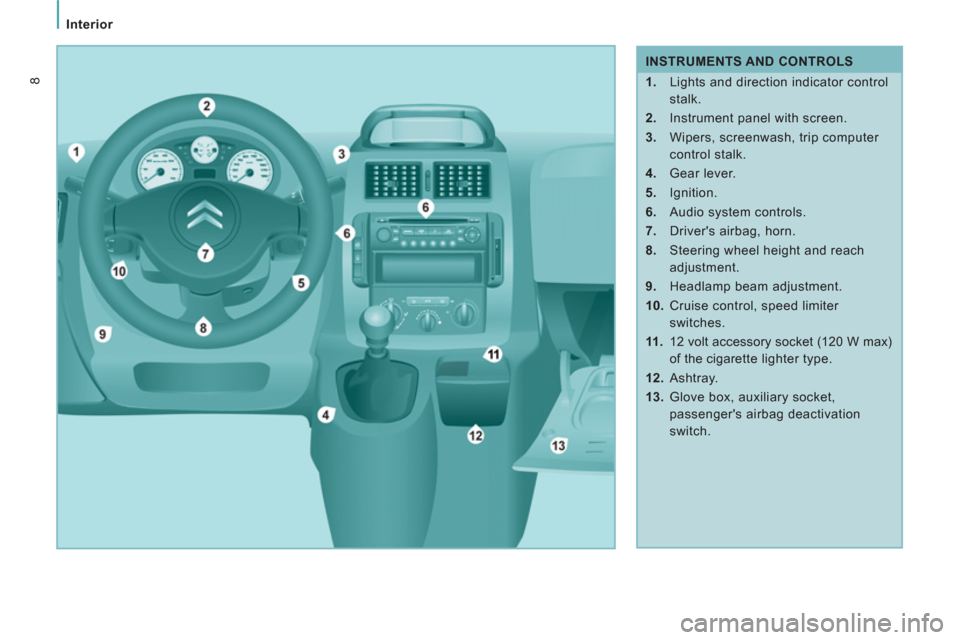
Interior
8
INSTRUMENTS AND CONTROLS
1.
Lights and direction indicator control
stalk.
2.
Instrument panel with screen.
3.
Wipers, screenwash, trip computer
control stalk.
4.
Gear lever.
5.
Ignition.
6.
Audio system controls.
7.
Driver's airbag, horn.
8.
Steering wheel height and reach
adjustment.
9.
Headlamp beam adjustment.
10.
Cruise control, speed limiter
switches.
11 .
12 volt accessory socket (120 W max)
of the cigarette lighter type.
12.
Ashtray.
13.
Glove box, auxiliary socket,
passenger's airbag deactivation
switch.
Page 13 of 268
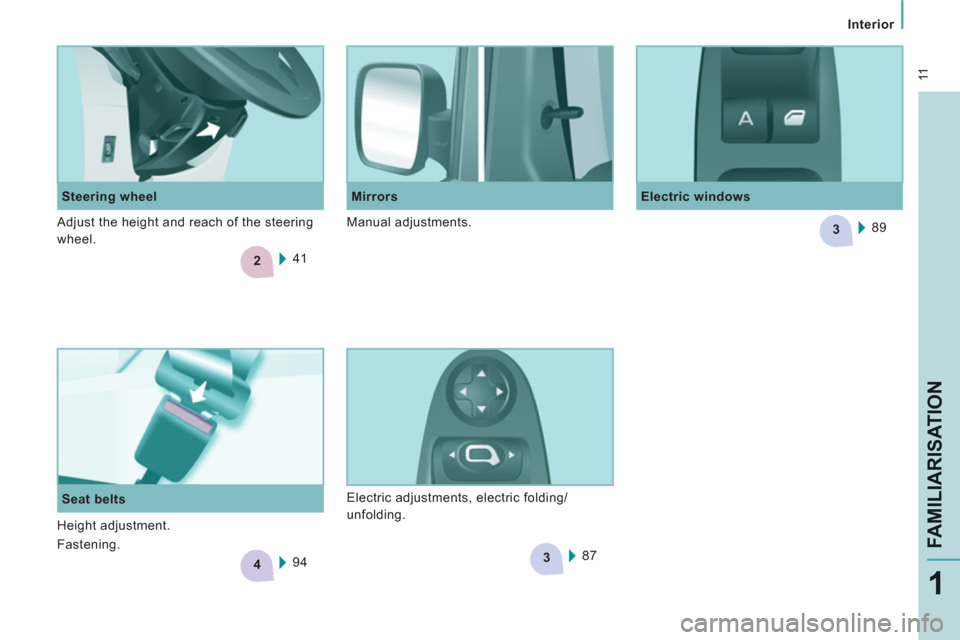
2
4
3
3
11
Interior
FAMILIARISATIO
N
1
Steering wheel
Electric windows
Mirrors
41
Seat belts
94 89
87 Adjust the height and reach of the steering
wheel. Manual adjustments.
Electric adjustments, electric folding/
unfolding.
Height adjustment.
Fastening.
Page 20 of 268
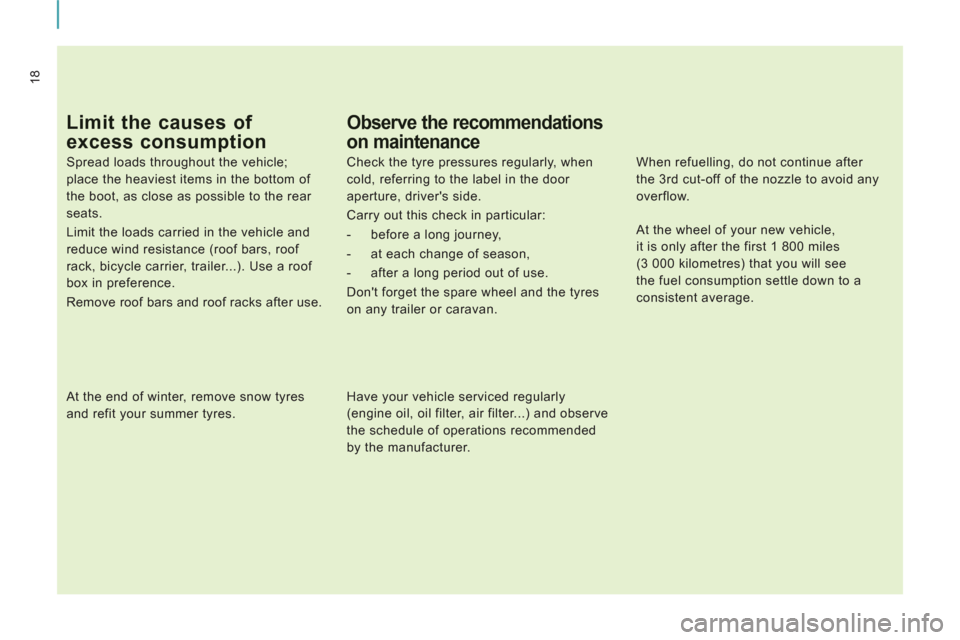
18
Limit the causes of
excess consumption
Spread loads throughout the vehicle;
place the heaviest items in the bottom of
the boot, as close as possible to the rear
seats.
Limit the loads carried in the vehicle and
reduce wind resistance (roof bars, roof
rack, bicycle carrier, trailer...). Use a roof
box in preference.
Remove roof bars and roof racks after use.
At the end of winter, remove snow tyres
and refit your summer tyres.
Observe the recommendations
on maintenance
Check the tyre pressures regularly, when
cold, referring to the label in the door
aperture, driver's side.
Carry out this check in particular:
- before a long journey,
- at each change of season,
- after a long period out of use.
Don't forget the spare wheel and the tyres
on any trailer or caravan.
Have your vehicle serviced regularly
(engine oil, oil filter, air filter...) and observe
the schedule of operations recommended
by the manufacturer.
When refuelling, do not continue after
the 3 rd cut-off of the nozzle to avoid any
overflow.
At the wheel of your new vehicle,
it is only after the first 1 800 miles
(3 000 kilometres) that you will see
the fuel consumption settle down to a
consistent average.
Page 34 of 268

32
Instruments and controls
Warning lamp
is
indicates
Solution-action
Brake pads on. brake pad wear. Have the pads replaced by a CITROËN dealer or
a qualified workshop.
Dipped beam
headlamps/
Daytime
running lamps
on. manual selection or automatic
lighting. Turn the lighting stalk to the second position.
lighting of the dipped beam headlamps
from the time the ignition is switched
on - daytime running lamps. Depending on the country in which the vehicle is sold.
Chapter 3, "Steering mounted controls" section.
Main beam
headlamps pulling the stalk towards you. Pull the stalk to return to dipped beam headlamps.
Direction
indicators flashing with
audible signal. change of direction via the
lighting stalk, to the left of the
steering wheel. To the Right: control to be pushed upwards.
To the Left: control to be pushed downwards.
Front foglamps on. manual selection. The foglamps only operate if the sidelamps or dipped
beam headlamps are on.
Rear foglamps on. manual selection. The foglamps only operate if the sidelamps or dipped
beam headlamps are on. In conditions of normal
visibility, take care to switch them off to avoid any
penalty. "This light is a dazzling red."
Particle
emission filter on. a malfunction of the particle
emissions filter (Diesel additive
level, risk of clogging, ...). Have the filter checked by a CITROËN dealer or a
qualified workshop. Chapter 6, "Checks" section.
Page 39 of 268

37
Gearboxes and steering wheel
READY to GO
2
To change gear easily, always press the
clutch pedal fully.
To prevent the mat from becoming caught
under the pedal:
- ensure that the mat is positioned
correctly,
- never fit one mat on top of another.
When driving, avoid leaving your hand on
the gear knob as the force exerted, even if
slight, may wear the internal components of
the gearbox over time.
GEARBOXES AND STEERING WHEEL
5-speed gearbox
6-speed gearbox
Reverse gear
In the 6-speed configuration, raise the collar
under the gear knob to engage reverse gear.
Never engage reverse gear before the
vehicle is completely stationary.
The lever should be moved slowly to reduce
the noise on engaging reverse gear.
GEAR SHIFT INDICATOR
In order to drive as fuel effi ciently
as possible with a manual gearbox,
this indicator lamp indicates to the
driver to change up.
The driver remains responsible for deciding
whether or not to follow this indication, since
the indicator lamp comes on without taking
into account the confi guration of the road, the
amount of traffi c and safety factors.
The lighting of this indicator lamp cannot be
deactivated.
When reverse gear is engaged
and when changing down whilst
decelerating, the function is disabled.